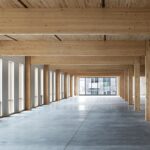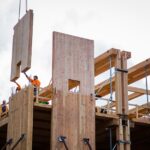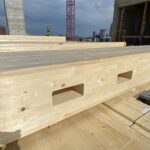Expert Tips
Standards and Guidance for the Construction of Wood Storm Shelters
Requirements and guidance for community and residential storm shelters, links to testing results, and additional resources.
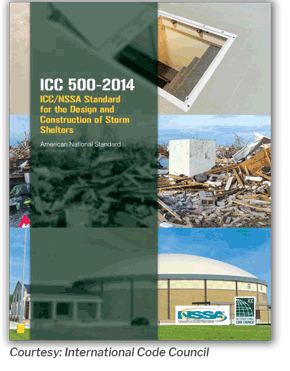
Storm shelter construction is covered in Section 423 of the International Building Code (IBC), which references ICC/NSSA 500: Standard for the Design and Construction of Storm Shelters.
The standard covers various topics related to shelter construction, including:
- Structural design and inspection
- Site requirements
- Minimum floor area per occupant
- Egress
- Fire safety
- Ventilation
- Sanitation
- Emergency lighting
- Testing
Storm shelters are divided into two categories, as defined in ICC/NSSA 500 Section 202:
- Community Storm Shelter. Any storm shelter not defined as a Residential Storm Shelter.
- Residential Storm Shelter. A storm shelter serving occupants of dwelling units and having an occupant load not exceeding 16 persons.
Requirements for both types are detailed in the standard.
Per IBC Section 423, ICC 500-compliant storm shelters are required for group E occupancies holding 50 people or more, 911 call stations, emergency operation centers, and fire, rescue, ambulance, and police stations when located within the 250-mph tornado design wind speed zone per Figure 304.2(1). Where the designated storm shelter will be a room or space that is normally used for other purposes (i.e., storage room, office, conference room, etc.), IBC code requirements for its use (occupancy) still apply. If the shelter is to be a separate, dedicated facility that will protect 50 people or more, it is to be classified as an A-3 occupancy. Separate facilities holding less than 50 people are to have an occupancy as determined by the IBC.
Storm shelters can be built using wood and placed inside buildings of Type III, IV, or V construction. For community shelters, ICC/NSSA 500 Section 601.1 notes that fire barriers and horizontal assemblies separating spaces or areas designed as storm shelters from other building areas shall have a minimum fire-resistance rating of 2 hours and shall be constructed in accordance with the applicable building code.
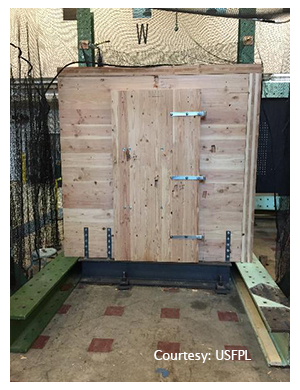
The U.S. Forest Products Lab (USFPL) has completed wind pressure and missile impact testing on wood storm shelters intended for residential/small business applications using both commodity lumber products and cross-laminated timber (CLT) as the main components for walls and roofs. Testing of various designs showed compliance with the ICC/NSSA 500 standard and wood was proven to be an effective building material for storm shelters. For more information on the USFPL reports and details of the shelter construction used in the testing, see the following resources:
- Development of a Ready-to Assemble Tornado Shelter from Cross-Laminated Timber (CLT), Impact and Wind Pressure Testing– USFPL, April 2019
- Video of Robert Falk speaking about the project during the 2018 Mass Timber Conference
- Residential Tornado Safe Room from Commodity Wood Products Design and Development– U.S. Department of Agriculture (USDA), February 2018
- Residential Tornado Safe Room from Commodity Wood Products, Impact and Wind Pressure Testing– USDA, February 2018
- Wind Pressure Testing of Tornado Safe Room Components Made from Wood– USDA, November 2016
- Development of a Tornado Safe Room Door from Wood Products, Door Design and Impact Testing– USDA, September 2016
- Residential Tornado Safe Rooms from Commodity Wood Products, Wall Development and Impact Testing – USDA, October 2015
- Wood Tornado Shelter Construction Guide– USFPL, November 2018
- 8’x8′ Wood Tornado Shelter drawings– USFPL
Similarly, FEMA Publication P-320 contains plans for yet another ICC/NSSA 500-compliant wood shelter design, which can be referenced here.
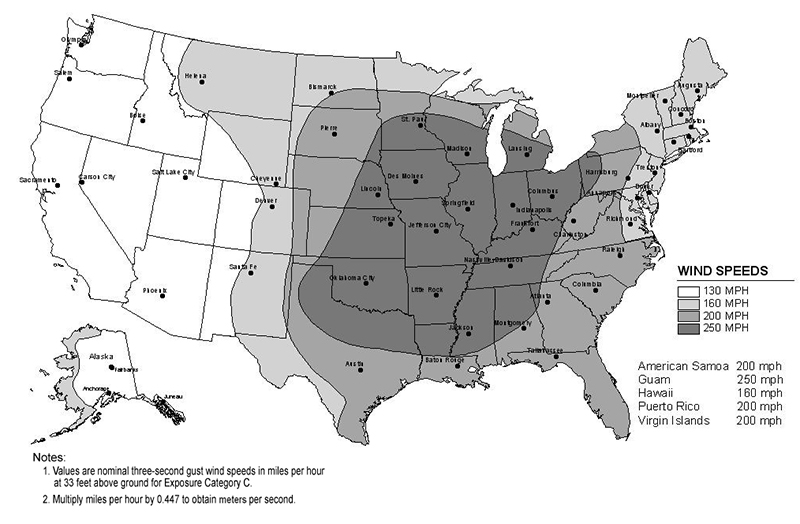
Larger community or commercial wood storm shelters can be realized following the proper design and testing protocols outlined in the ICC/NSSA standard. Test specimens for the shelter can be tested as individual components (i.e., door, window, wall panel, roof panel, etc.) but need to be full size. Structural design criteria are listed in Chapter 3. Two notable considerations are design wind speed, located in Figures 304.2(1) and 304.2(2), and missile impact, detailed in Section 305. The standard test missile for tornadoes is a 13ˈ-6̎ long, 15-pound 2×4 launched at varying speeds up to 100 mph. Hurricane 2×4 missiles weigh 9 pounds, are 8ˈ-4̎ long and are launched at a speed that is half of the design wind speed. When the shelter is to provide protection from both tornadoes and hurricanes, the entire structure is to be designed using the most restrictive requirements of each hazard for all criteria.
For both new and existing construction, storm shelters constructed of wood can provide a cost-effective solution that is relatively easy to assemble. For the latest updates on wood storm shelter testing, contact the help desk at help@woodworks.org .
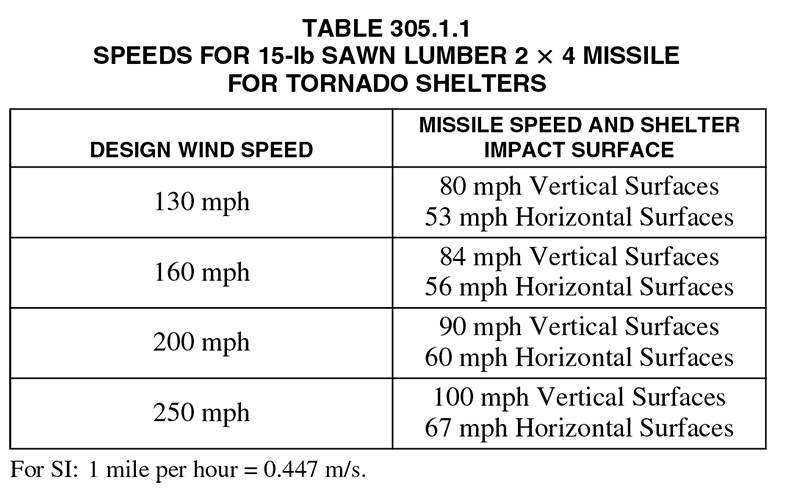
Additional Resources:
- Tornado Shelter landing page and resources – USFPL
- The Wood Tornado Shelter: A Cost-Effective Retrofit Solution– USFPL, November 2018
- FEMA 361: Safe Rooms for Tornadoes and Hurricanes: Guidance for Community and Residential Safe Rooms – FEMA, March 2015
- Construction Materials Threshold Testing – Wind Science and Engineering Research Center, Texas Tech University, November 2014
- Highlights of ICC 500-2014, ICC/NSSA Standard for the Design and Construction of Storm Shelters – FEMA, September 2015

